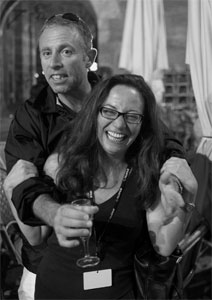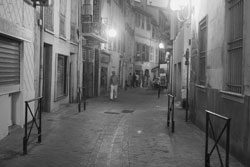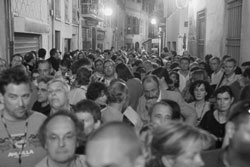 |
→ September 2005 Contents → Column
|
Letters from Central America:
Visa Pour L'Iver D'Amage |
 |
||||||||||
|
Let's face it. As far as groups of people go, photographers really know how to kick ass when it comes to gatherings. If you're a Young Republican your big confab was in Las Vegas in July, average temperature maybe 140 (Fahrenheit) in the shade. If you sell electric guitars, one of your major gatherings was in Indianapolis in July. Temperature in Indy? Who cares; you're in Indianapolis. If you're a photojournalist or in any way connected with photojournalism, your big get-together is in Perpignan, France, during the first week of September. The South of France? Next to the Mediterranean? I have to tell you that not only doesn't it suck but it doesn't get much better than that.

The best parties and dinners are by invitation only and if you're not on "the list" you ain't gonna get in. Two wasped-waisted, bandy-legged waiters named Pierre gave a few of the older people here at the National Geographic party Studio 54 flashbacks by taking their sweet time searching "the list" for names. Their power only comes once a year so they must like exercising it. There may have been a group of young photogs that either climbed a wall to get into the Nat Geo party or snuck in through (oh, the irony) the waiters' entrance. I hope it happened, but I didn't get a confirmed sighting.
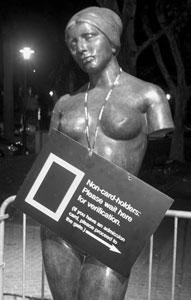
The fantasy of Perpignan, particularly for young photographers, is somewhat like the fantasy held by the starlets that used to hang out at Schwab's Drugstore in Hollywood, that they'll be "discovered" by an editor or agent. So they truck down to this admittedly excellent city like a bunch of music lovers going to Woodstock, except that instead of a guitar and a backpack filled with illegal drugs they all carry a camera bag and a laptop case.
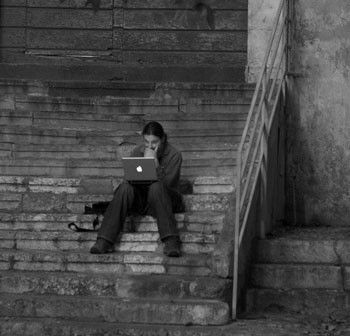
They open up their Powerbooks at the slightest nod from another sentient being and show off their work, their projects and their résumés.
The fact seems to be that, unless you're already an established photojournalist, you probably won't walk away from Perpignan with much in the way of assignments or contracts. But you will walk away with CONTACTS.
Sitting at the semi-official hub of activity, the Grand Café (near the Castille), imbibing beers, pastis (it's like a liquid, alcoholic shot of Good & Plenty for those who like American boxed candies) or coffee, you'll get to talk to, at one table, a group of shooters from Portugal, Canada and the U.S. At another there are Germans, Swedes and the French, and this repeats itself over and over again throughout the week. The wealth of experiences here is wonderful and you can really get a sense of how many people give a damn about taking pictures. They might be struggling to survive but they really do care about their art.
You can also benefit from the critical evaluations that others may offer, and when I say "critical" I mean supportively so.
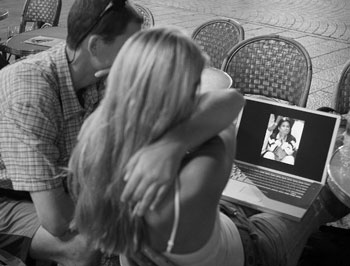
There isn't a mean thing to be heard the whole week and when someone talks to you about your work it's always with the idea of helping you to do what you're doing better.
So is Perpignan worth visiting? Absolutely. It's a wonderful week-long party with a photographic theme. You can wander from exhibition to exhibition and get some serious inspiration. You'll see things that you'd never have believed possible (Life magazine photo editor John Morris being asked to sign the t-shirts of some Japanese attendees, for example).

You can meet old friends and make new ones. You can go to the nightly "slide show" at Campo Santo

and mock the lesser presentations that seem to have too many pictures of nothing very interesting done in a boring style. You can also see some wonderful work and hear people like Time's Yuri Kozyrev talk about life.

Then it's back to the Grand Café for drinks until 3 a.m.

Practical Tips:
Book early. I tried to book a hotel in Perpignan about a month before the start of Visa Pour L'Image and the closest I could get was 12 km (7.5 miles) away. I got lucky when someone had to leave on Wednesday (thank you, David McIntyre) so I picked up his room in a downtown hotel, bringing the commute to the Grand Café down to 200 yards.
You can fly into Perpignan via Paris or London (Stansted). You can fly into Toulouse (120 miles away) and take a train. You can get totally psychotic by waiting until the last minute and booking a flight into London (Gatwick), taking two trains, getting on the Eurostar to Paris, getting from one Parisian station to another to hop on a TGV to Marseille and then pick up a rental car for the 200-mile drive to Perpignan. You'll only do that last one once.
If you're coming from North or South America make Perpignan the first stop on your European tour. The time zone difference works to your advantage as the typical Perpignan day (wake up at noon, go to bed at 4 a.m.) works out to be a somewhat normal 5 a.m. to 9 p.m. day according to your body's internal clock.
Get to Campo Santo early for the nightly slide shows.

The doors "open" at 9:30 p.m. but be there at least an hour early to ensure getting in. The lines get progressively longer as the week goes on and by Saturday they're huge.
Save at least some strength for the big party on Saturday night - or actually Sunday morning. It starts at midnight after the final slide show and goes on until dawn and they had a bottle of champagne for each party-goer.
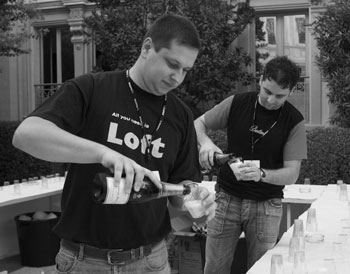
The DJ's good and the music (in the inner courtyard of a former convent) loud. It's a rave.
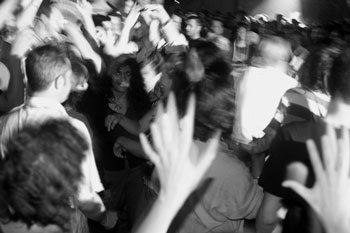
Best quote of the night? That would have to be from a young male photographer to a young female photographer: "I can BE Bruno Stevens for tonight." Second best quote? "Why are you taking my picture?"
Acknowledgements:
Jean-Francois Leroy: Founder and director for, oh, these 17 years of Visa Pour L'Image. He runs an excellent festival and can work wonders with non-functioning cell phones. Tends to look a bit stressed towards the end of the week but always seems pleasant.
Scott McKiernan of Zuma Press: Eloquent, loquacious and a fluent French speaker who helped me with the title of this month's piece by translating "liver damage" into French. Who would have thought that two languages could be so similar?
The Canadians: Deeds, Don and Duane, who gave a much-needed North American (yet not American) perspective to things.
© James Colburn
Contributing Writer
|
|||||||||||
Back to September 2005 Contents
|
|
